Building a High End Listening Room 4: Fine-tuning the Acoustics
We bring you a comprehensive account of room acoustics tuning in our listening studio in Rožnov pod Radhoštěm. We have acquired a space in which we were able to realise our demanding requirements, ultimately leading to the best possible acoustic properties of the reference room.
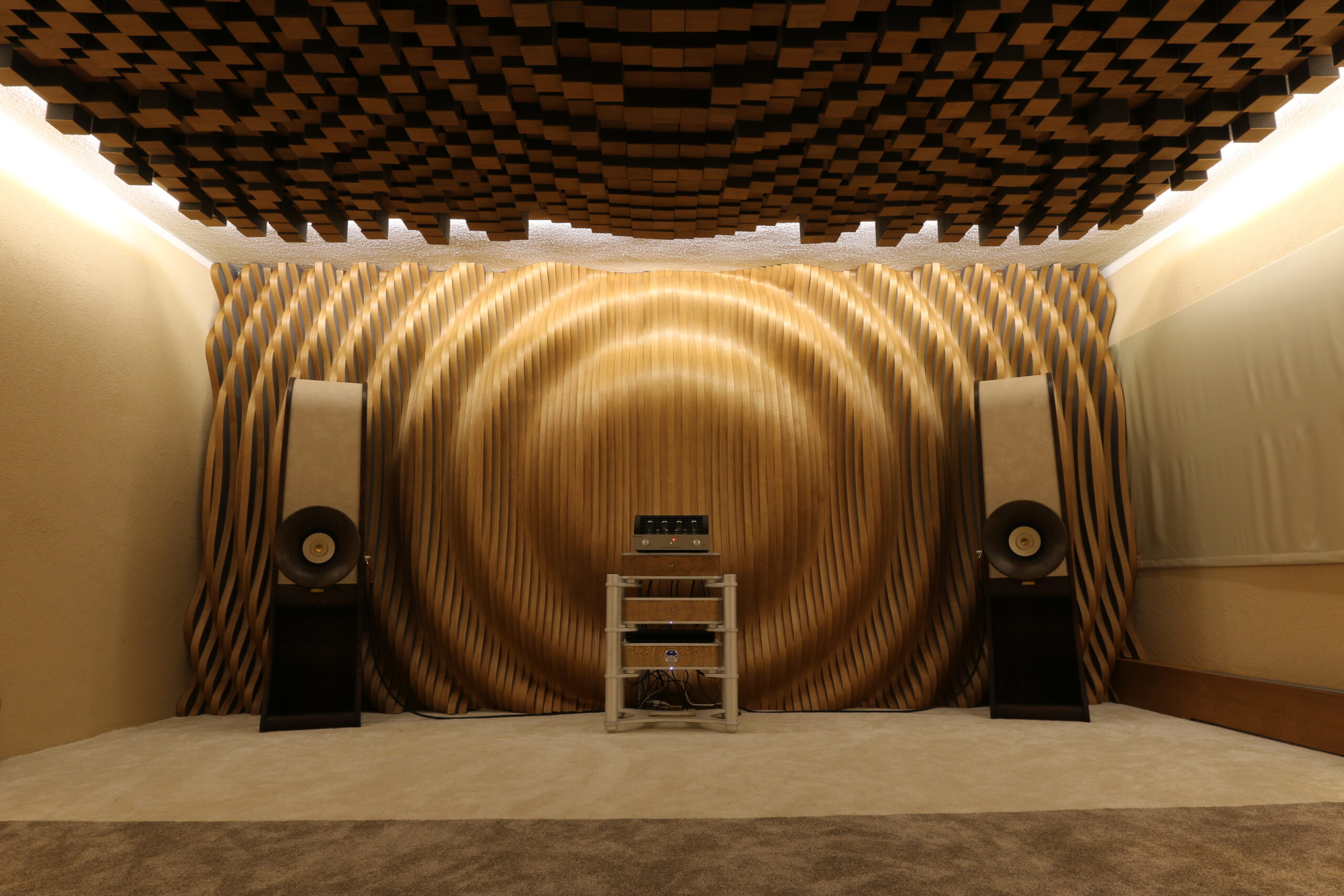
Basic Properties
- A quiet place, far from low frequency vibrations caused by cars, trucks, trams, etc.
- The room is situated at the back of the building, with a garden allowing for a space for our own grounding system.
- The building has a reinforced concrete skeleton, without any unwanted (from the point of view of acoustic) materials like plasterboard, which would be prone to resonate.
- By erecting a new wall, getting rid of a partition which was not suitable and bricking up niches and windows, we ensured an optimal side wall ratios and symmetry of the listening space in regards to modal frequencies.
- Conveniently, the electric mains has a transformer which is separate from the nearby industrial area.
- The stronger-than-needed power supply is newly laid down, going directly from the main switchboard of the building.
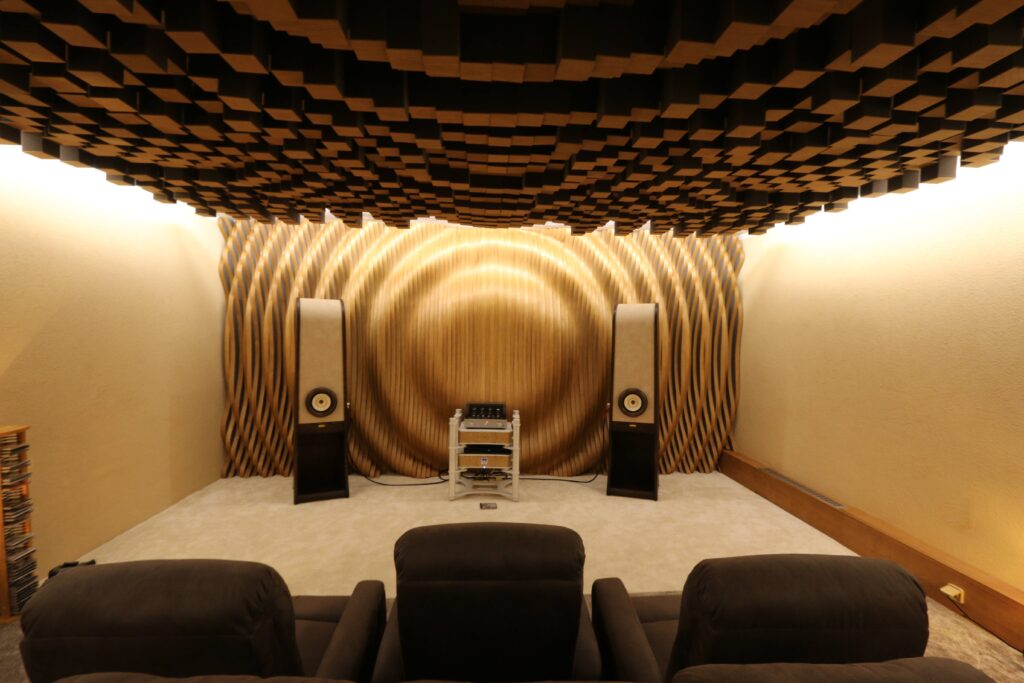
Presented are two different audio systems placed opposite of each other, the listener sits in the middle, in the ideal position given by the usual triangle. In the room, there is enough space to move the speakers and the listening spot with regards to modal frequencies.
Basic Acoustic Treatment
- In order to disperse acoustic reflections ideally and still keep most of the acoustic energy in the room, there is a hybrid quadratic diffuser placed on the ceiling. The depth of the pattern is 200 mm.
- The front walls by both the speaker systems are covered by a large hybrid diffuser; 5.64×2.6 m, with a pattern depth of 150 mm. It works from 128 Hz up, which is far behind the boundary of signal phase shift localisable by the human ear.
- Direct reflections from the side walls are eliminated by a coarse fabric and small acoustic accessories.
This hybrid diffuser absorbs low frequencies more and keeps the higher ones in the space, a large advantage in comparison to acoustic treatment that only absorbs.
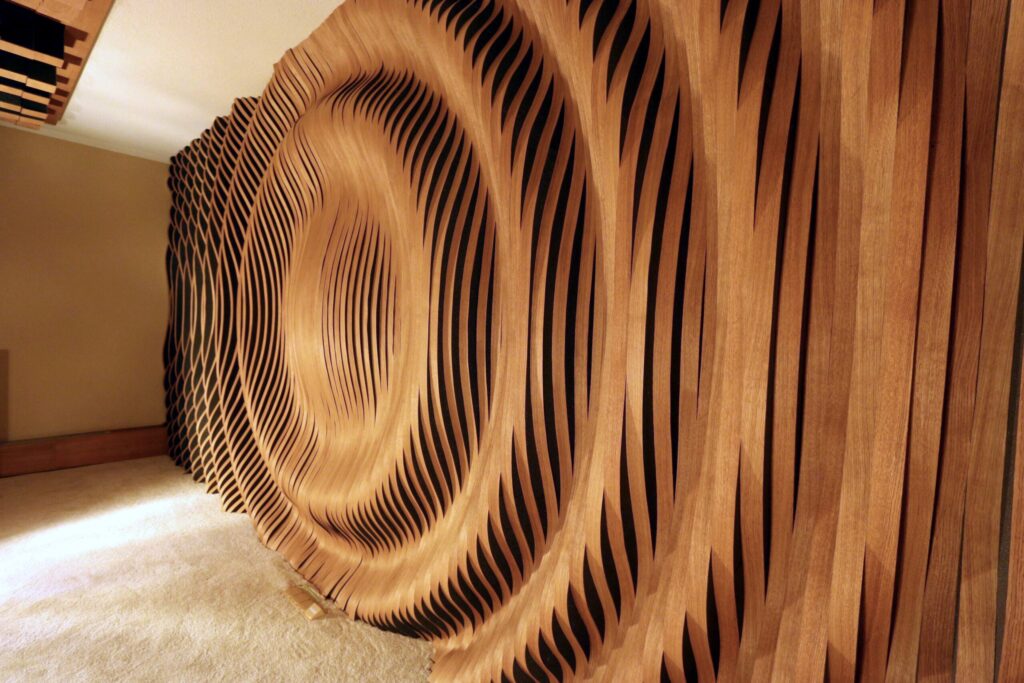
Reverberation Time
Is, from the point of view of acoustics, one of the main measurable parameters of a listening space. Long reverberation is unpleasant to the ear: Low frequencies stay in the space for too long. Too much bass acoustic pressure fills the room and details get lost. At first hear, the bass is mighty, it can even be perceived positively by some, but when listening longer, one gets tired. In opposition, a very short reverberation in a space that is overly dampened causes perceived constraint. The ideal is somewhere in the middle between these two extremes. Our goal is a specific, concrete, hard, dynamic and precise bass. A non-specific hum of a subwoofer is not what we are looking for.
We measured the length of reverberation using a speaker placed 1 m far from the front and 1 m from the side wall. Reverberation manifests most on low frequencies and it is standardly measured up to 200 Hz. Below, you can see how the reverberation time went down from a completely empty room, through the installation of the ceiling diffuser, laying down the carpet, installing the front diffusers and finally placing the armchairs.
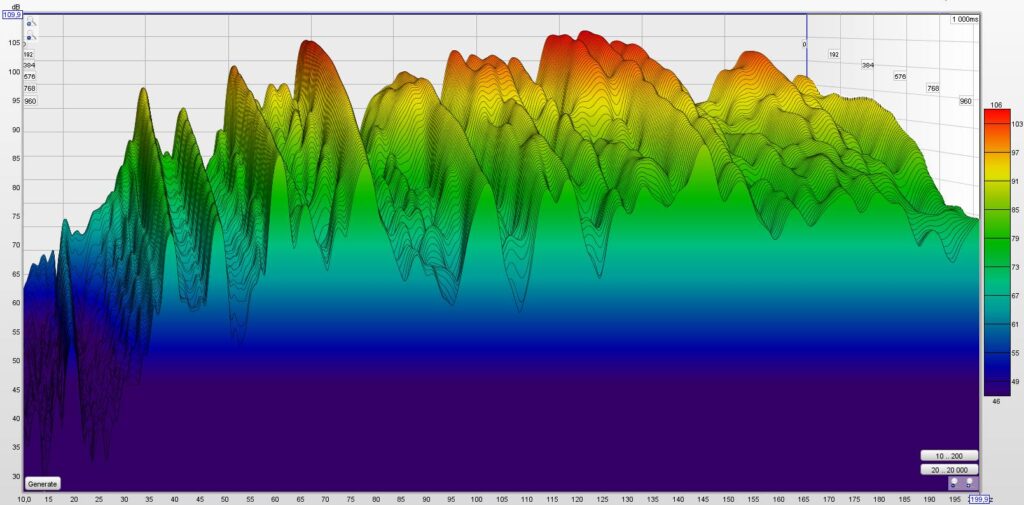
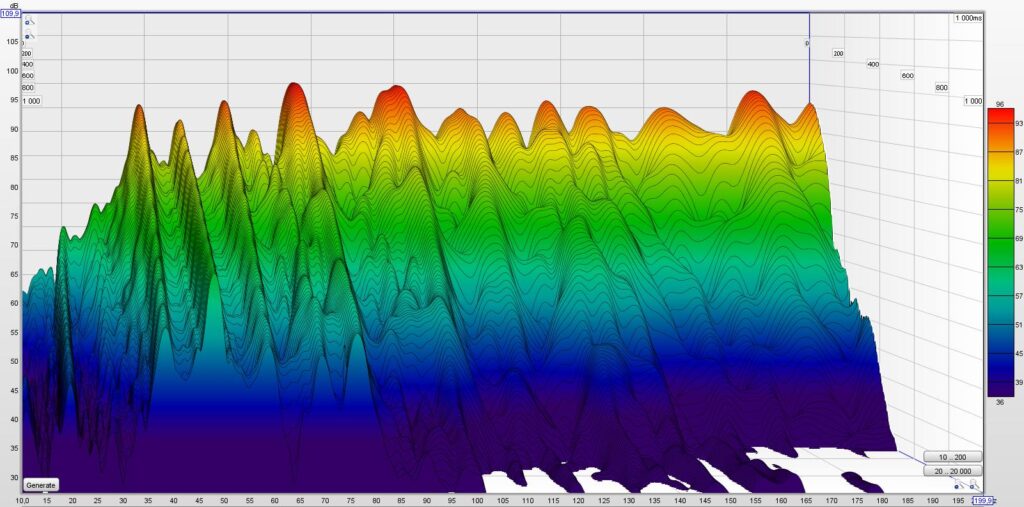
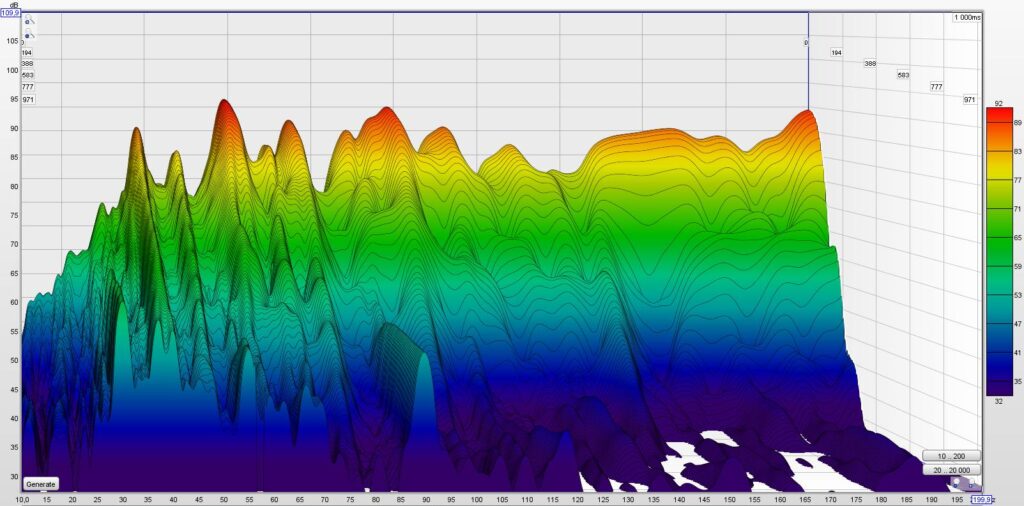
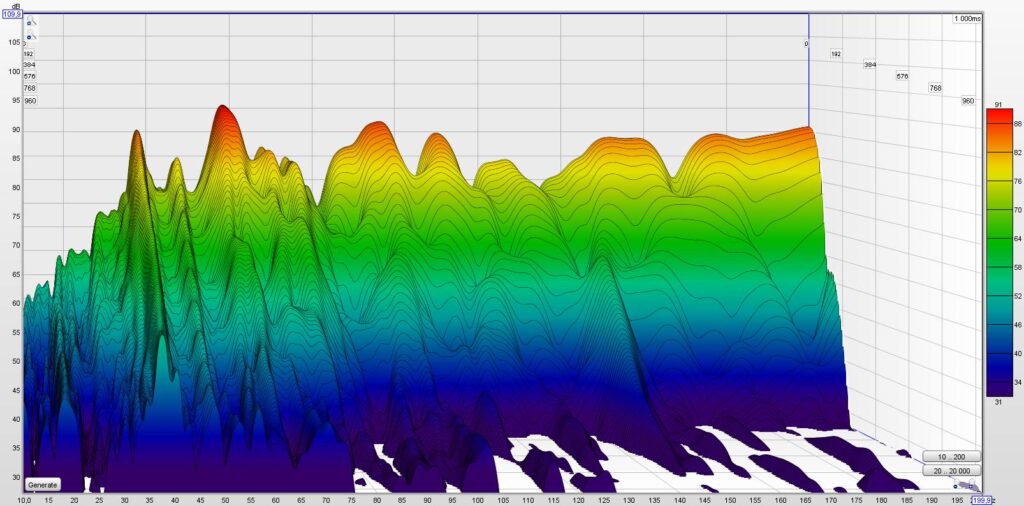
Simulation and Practice
Good old rules still apply. A small shift of the speakers position out of the simulated ideal point gives the sound the proper, perfect character and elocution.
The project began, as is usually the case, on paper. Once again, we found out that even the best calculations will differ from reality. Just as supercomputers fail with the prediction of weather more than five days ahead, acoustic simulation fails on the same premise. The most important thing in the equation is input data and the quality of the computational model. Just as real weather has in some places its local microclimate that is hard to simulate, so does an acoustic space have certain qualities that the computer model does not take into account. Basic acoustic parameters in spaces that are not too complex can, of course, be simulated. However, such is not the case for what the localisation of the instruments, or character and elocution of the space will be.
Measurements
Down below are measurements of the left and right speaker systems in the listening spot chosen using our ears. In a larger group of listeners, we have decidedly came to the opinion that this is the place where it sounds the best. The measurements are solely basic, for orientation. We have not made laboratory measurements of the diffusivity or absorption of the floor, walls, or the ceiling. These numbers often do not give detailed information as to the complex acoustic behaviour. Moving the microphone by 30 cm, the measured graph changes significantly.
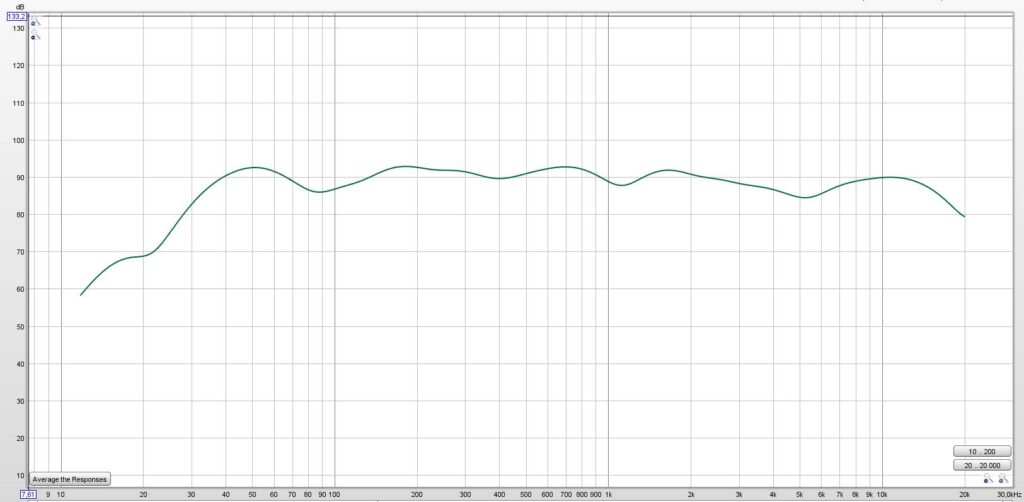
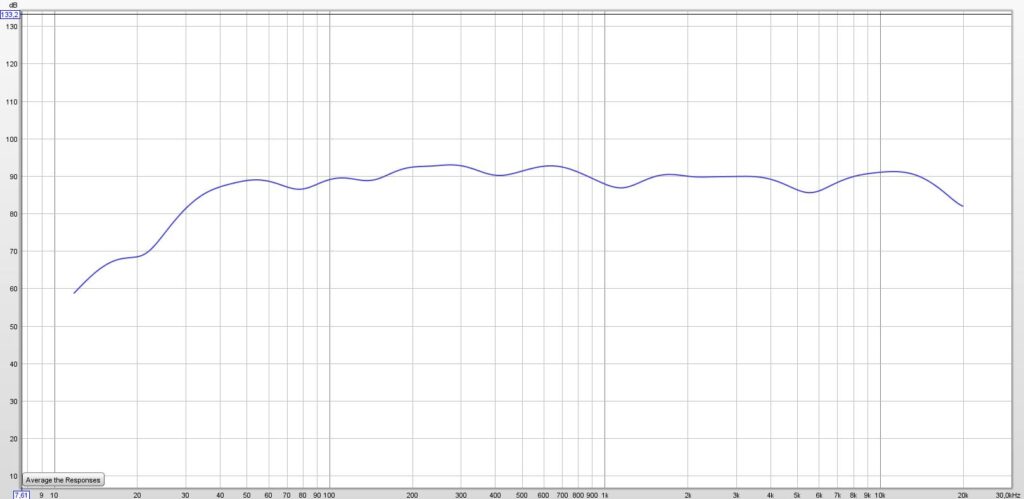
A few pieces of general proven advice for better acoustics
- The best speaker-listener position is always defined by an equilateral triangle (a few centimeters here and there).
- Overly dampened or completely undampened space is wrong – too great an amount of acoustically absorptive or reflective materials.
- Large areas of plate glass, plasterboard, wooden walls or paneling behave as resonators and are usually detrimental to good acoustics.
- Eliminate reflections from flat opposite walls, break up large flat surfaces.
- If the listening spot happens to be by the wall (a sofa close to the wall for example), dampen the back reflection from the wall, at least by a large pillow or a carpet.
- Pay attention to symmetry when it comes to acoustic treatment.
- Experiment. A blanket, a pillow… these are easily movable and you can find out by listening in which position they have a positive effect and according to the surface size and volume tested choose an acoustic canvas, tapestry or other acoustic accessories. Often, very little is needed for an acoustically “horrible” space to become “acceptable.”
- What we frequently observe at our customers’ spaces, is flutter echo. This happens especially in large open spaces where several rooms are connected by a large passage, with not enough absorptive materials. Carpets not your thing? Place acoustically absorptive treatment on the ceiling, thick curtains and other absorptive decorations on the walls.
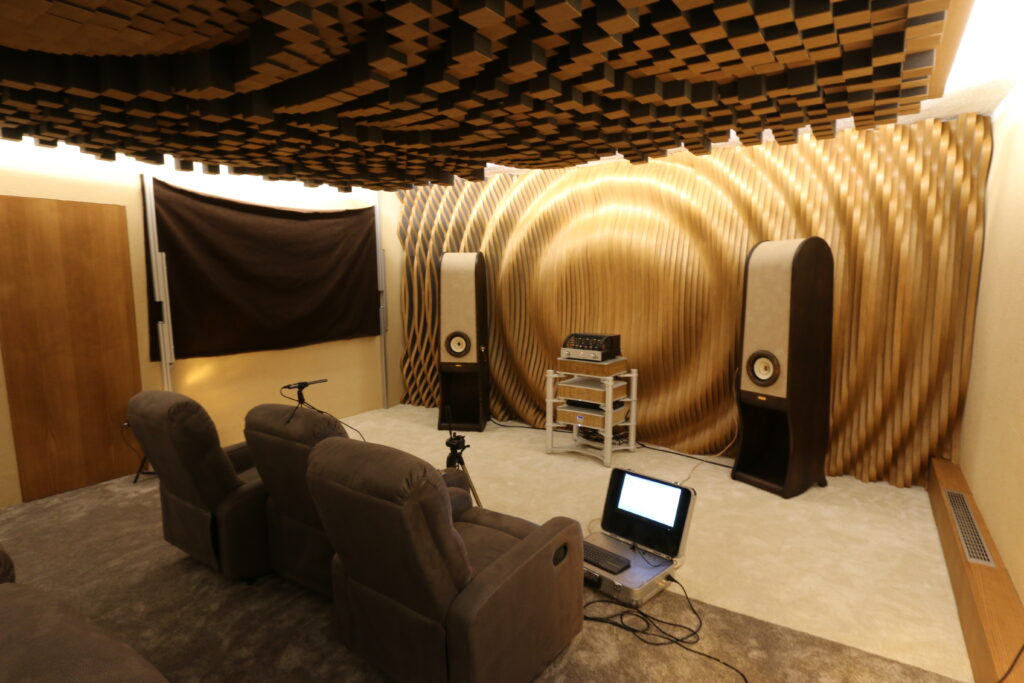
You cannot change modal frequencies of a room, but their influence can be optimised.
Elementary physics works everywhere. In most spaces where we had the possibility to take acoustic measurements, we heard with our own ears room modal frequencies. Using a five-second sweep tone where the frequency increases logarithmically, one can hear sound level fluctations. The effect is similar to changing stations quickly on an old radio; same intensity for a short time, a fluctuation, same, fluctuation. These are resonance, or modal frequencis of a room. Spaces where the distance between opposite walls forms multiples are problematic. For example, a room of 5x5x2.5 m will make one frequency and its harmonic multiples stick out. You can read more about the way sound acts in a closed space here.
In our listening space, we were able to achieve ideal ratio of the opposite wall distances, and overall symmetry.
Acoustic Interactions Inside the Listening Space
A speaker system changes electrical energy into mechanical energy. In our space of 8.7×5.45×2.6 m, plus a niche for the door, we have about 125 m3 of air. At room temperature, pressure and humidity, it weighs about 150 kg. Imagine a speaker driver, its thin membrane, as it interacts with 150 kg of air in the room. Sound is waves, its speed in air and in our conditions is approximately 345 m/s. We hear from approx. 20 Hz to 20 kHz, therefore we hear a wavelength spanning from 17 m at 20 Hz to 1.7 cm at 20 kHz. In regards to the closed space, we are interested in half waves of all frequencies; we are talking about distances between 8.5 m and 8.5 mm. As we are concerned with a closed space, in the size of audible wavelengths, resonances will occur: Certain frequencies stay in the space longer. These are modal frequencies of a room.
Moving the speakers in the space, their interaction with modal frequencies of the space changes. The weight of the speaker driver membrane, thickness of a curtain, volume of the speaker chamber – all these interact with the closed listening space, as it, on low frequencies, acts as a resonator. If you move the speakers, you can significantly influence their expression on different frequencies. The same goes for the ideal position of the listening spot.
The Ears Will Tell
If you clap your hands strongly, you will create a sound impulse that has a very wide frequency range. See the image below. The yellow intensity is background, the red the maximum value when a clap was heard. One can see that the frequency range is very wide. With your own ears, you will then easily evaluate how long does reverberation stay in a closed space and on what frequencies. You can try this simple method at home. In each room, the clap will sound differently. We can even hear modal frequencies of a room. The prerequisite is absolute silence. A strong clap in the corner of a room will sound differently than in the middle. These are the aforementioned resonance, or modal frequencies of a room.
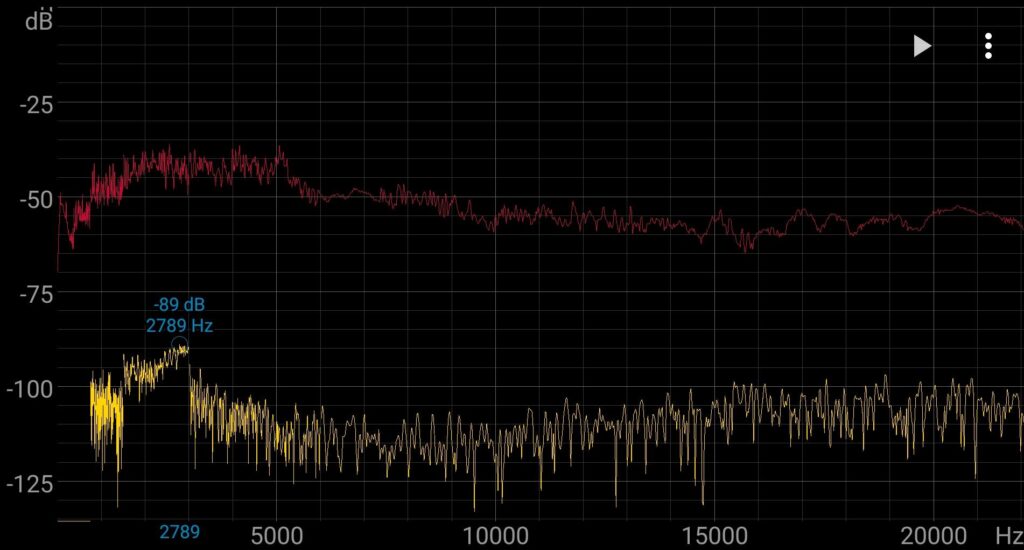
Final Acoustic Adjustments
On low frequencies, we lowered the reverberation to the required limit using hybrid diffusers, carpets and upholstered furniture. The space is still very vibrant on high frequencies, with a noticeable resonance between the side walls. We are temporarily placing a coarse fabric on the wall to get rid of the direct reflections on high frequencies. Up, down, up, down, too much or too little? The fine-tuning of acoustics is not measurable or countable; it is very subtle and subjective. The goal is for the songs to sound as best as possible, for the contour of string instruments to surface and stand out, for the piano to have exactly the colour it has in reality. We cover the door niche with a thick curtain and place fabric on the right wall. A step in the right direction. We are once again looking for the ideal listening spot… It changes with every adjustment and everybody may perceive it a bit differently.
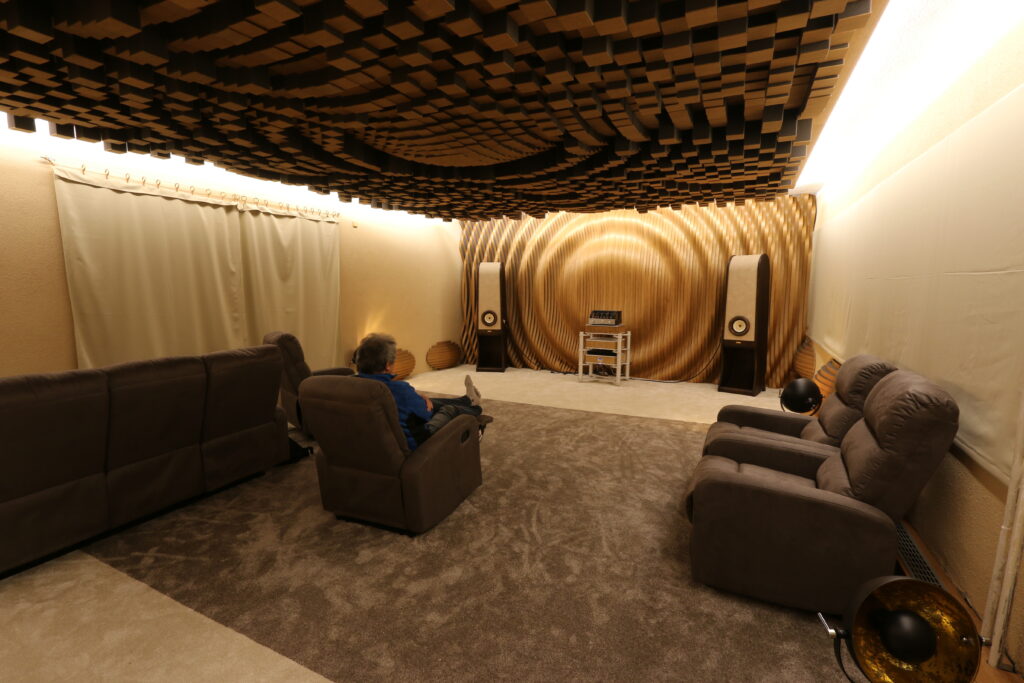
Acoustic Lens
Covering a part of the right wall with fabric has removed unwanted reflections from said wall on higher frequencies, but something else is also needed. We agree that a slight diffusivity on the side walls would definitely benefit this listening space. An acoustic lens has been created as a missing piece in the puzzle. A light accessories, easy to hang on a wall, which creates diffusivity in a wide frequency spectrum.
Acoustic Character of the Listening Space
Simply put, the sound expression is fuller, yet more detailed and with an even more powerful and precise bass undertone. Thanks to the dominant diffusers which help primarily with the spatiality of a recording, thanks to the controlled reverberation time and modal frequencies that are not overlapping, the room withstands much larger acoustic load until it, as the expression goes, falls apart. As was mentioned above, acoustic pressure of modal frequencies stays in a space longer. Once these modal frequencies add up and go over an uncomfortably loud boundary, we say that the room “falls apart.”
The Wiring and Power Grid Interference
We cared when laying down the wires. The supply going from the main switchboard into our secondary switchboard is a direct one. Each power circuit has its own fuse. We chose two phases with the least interference to power the speaker systems. Both of them are powered from a standalone separate circuit using our RD EMI Neutralizer power filter with isolation transformers. They change electrical energy into magnetic field, which is in the secondary winding changed back. Each audio system has its own grounding system, so they are completely separated from the power grid. A detailed post on the wiring, filtration of high frequency elements in the power grid and grounding quality will come another time. Down below are approximate measurements of high frequency interference on three separate phases in our switchboard.
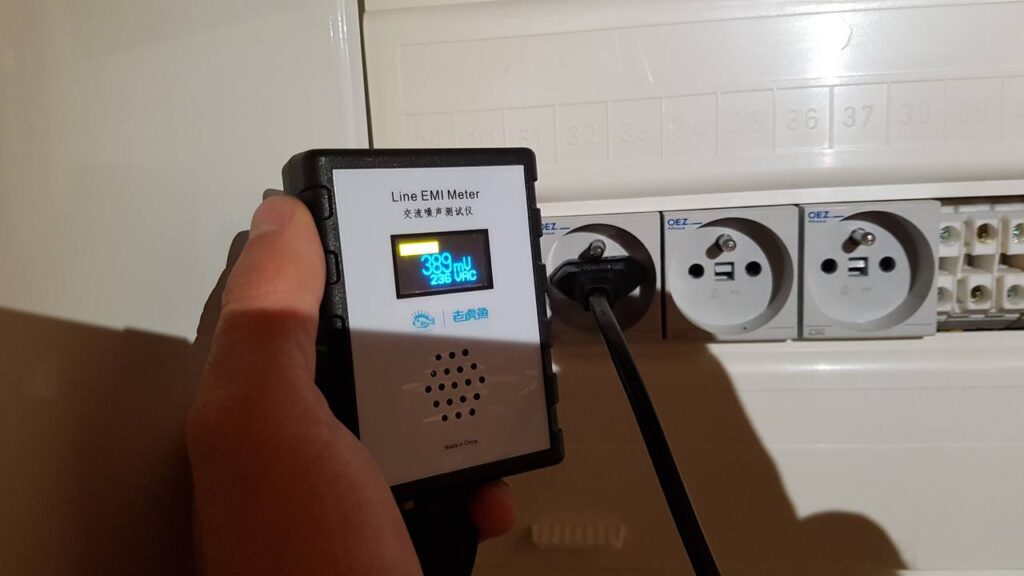
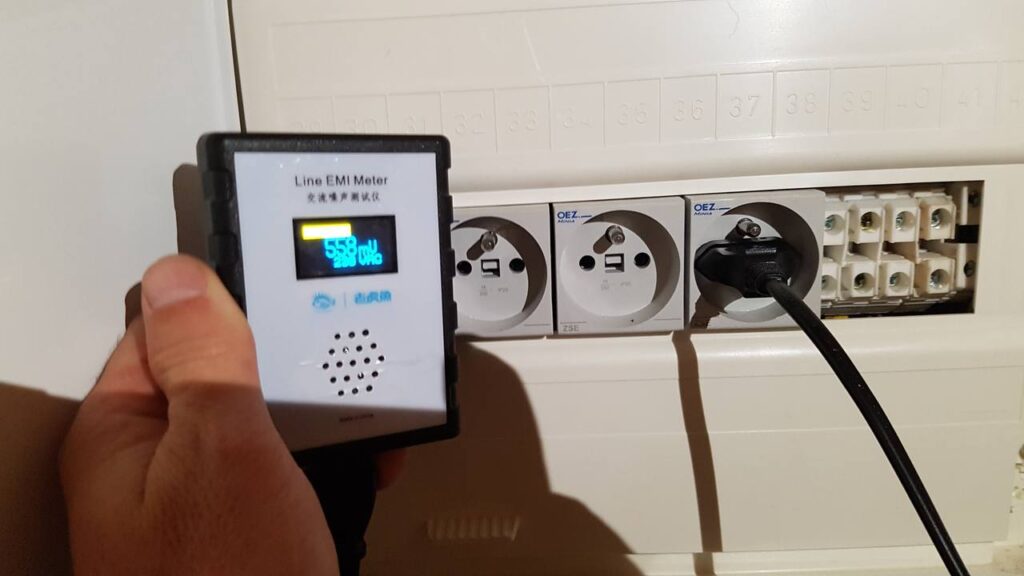
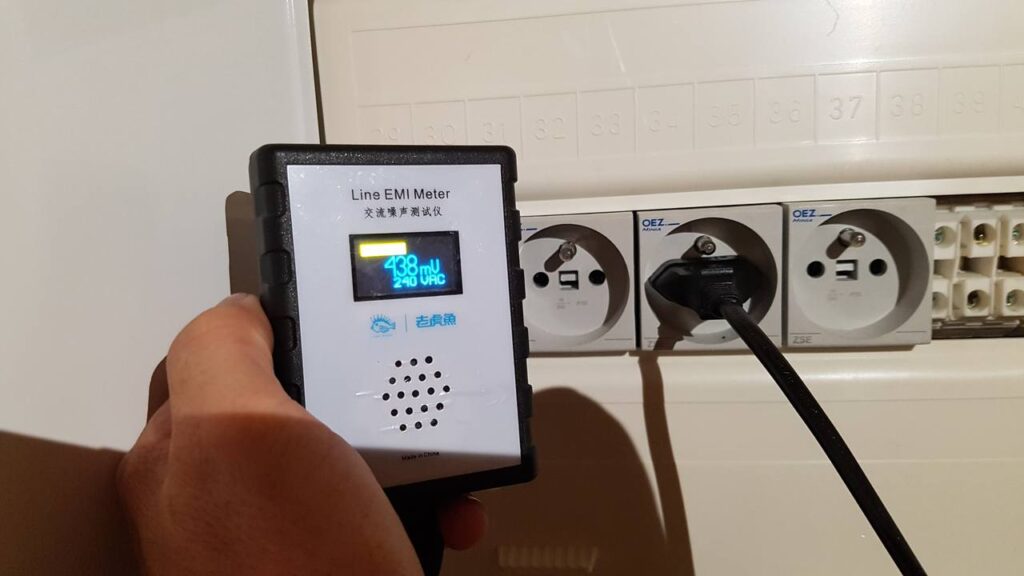
First Audio System
- Horn speakers Evolution
- RD EMI Neutralizer TT – separate power grid with its own grounding system
- RD APC – a computer optimised for audio
- RD DAC – DA converter 24Bit 384kHz
- UHD Blu-ray UBP-X1000ES
- Temporarily a Primaluna amplifier
Acoustic Impedance
The horn speakers Evolution have only one highly sensitive full range speaker driver without a crossover. Crossovers divide and shift signal phase at the dividing frequency. They lower the clarity of details and the overall spatiality of the output. That is why going crossover-less benefits extraordinarily the reproduction of the finest details in a recording. The Evolution horn baffle uses the energy of the back wall of the speaker driver membrane and transfers it to the air. In a way, it is a kind of acoustic transformer with its own mechanical impedance in the exhale part of the speaker. The position of these speakers is therefore key in regards to room modal frequencies.
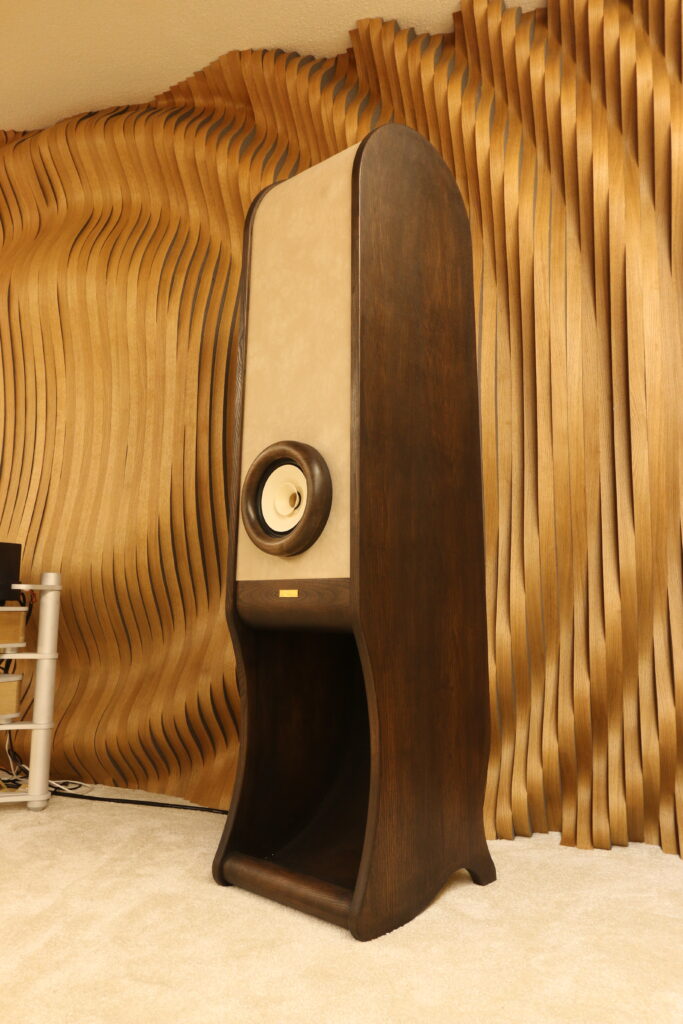
Front Horn Oris500
Years ago, we constructed an additional front horn for the Evolution speakers. It directs acoustic pressure of the speaker driver from approx. 500 Hz up towards the listener. It is not suitable everywhere—its properties excel more in larger rooms. In our space, it clearly adds to the sound, bringing even more spatiality and juiciness.
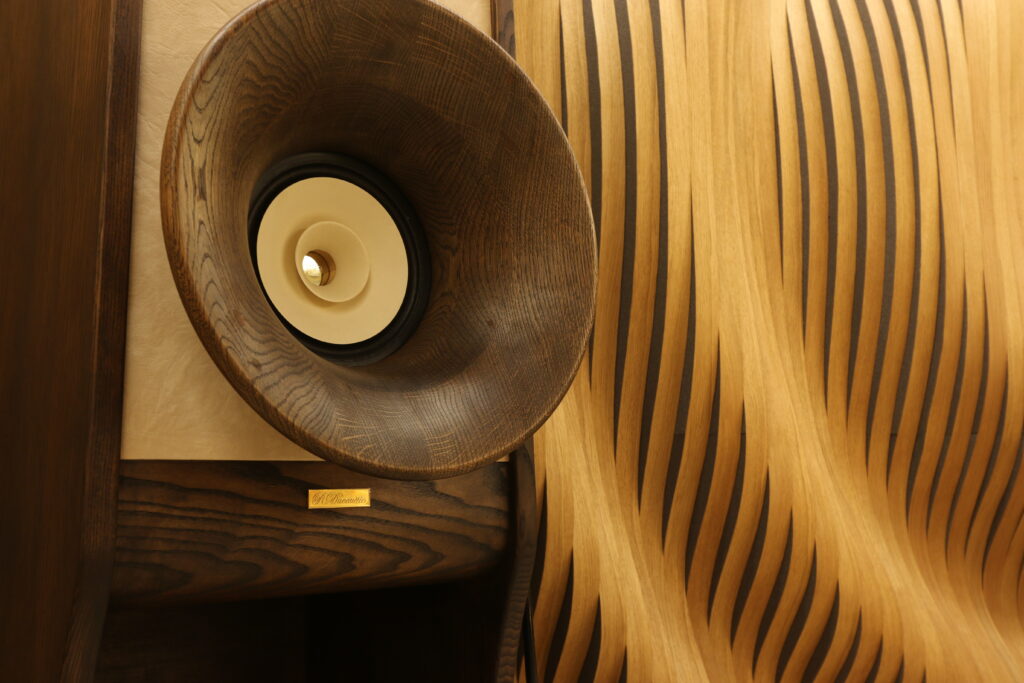
Listening
The experience of listening to music is to be savoured as an excellent food from quality ingredients in a gourmet restaurant. With a phone, tablet, PC or TV, we can only imagine its scent, taste and the feelings it provokes. In the following part, we will try to bring you closer to what we felt when listening to several pieces. Some of the works are provided with videos with an audio track, which is only for orientation. The quality is by far not close to the original; it is only a video recording from our high end studio.
Santana Brothers – Contigo (with you)
In 1994, Carlos Santana, his brother Jorge, and nephew Carlos Hernandez recorder the album Brothers. Carlos is a Mexican-American musician, guitarist and singer, who, with his distinctive style, influenced rock music in a decisive way. He is considered to be one of the best guitarists in the world. Santana’s guitar solos are definitely worth listening to.
Lena Ledoff Trio – Wish
In 2002, the phenomenal pianist Lena Ledoff came out with a well recorded jazz album Wish. A precise piano, bass (Wojciech Czajkowski) and drums (Przemysław Knopik) in a crazy energetic rhythm.
The instruments do not overlap, the contour is precise. In the background, one can hear the touching of the bass strings, which lures one into the real action of the piece. Great experience.
Land of Giants
A world renowned pianist McCoy Tyner, phenomenal vibraphonist Bobby Hutcherson, bass Charnett Moffett and drummer Eric Harland created an extraordinary piece of music. The omnipresent clapping of the strings on the fingerboard is heard across the compositions. Bobby Hutcherson gives us a technically brilliant and tasteful play. Colour-wise, his instrument melts with the piano wonderfully. The calming moments predicting the final gradation of the opus consist of a bass dialogue which Moffett leads with himself, on the platform of the infallibly rolling accompaniment of Eric Harland.
Chris Jones – Moonstruck & No looking back – Long after you’re going
Stockfish Records, 2000 (LC04910). Spatiality, clarity of the elocution of individual instruments, their pleasing coloured reverberation. Essential listening.
Musica Nuda – Complici
An unconventional duo Petra Magoni – Ferruccio Spinetti had recorded their first spontaneous album Musica Nuda, which has later on become the name of the duo itself.
A little bit of jazz, a little bit of songwriting, some elements of rock, punk and occasional vibrations of classical. When music becomes “naked,” there are no boundaries. The duo has gained significant popularity in Italy especially thanks to the original, cultivated-popular, simple and yet articulated expression.
Bedřich Smetana – Má vlast (My Country)
SACD LS00516 – Sir Colin David – London Symphony Orchestra. Listening to Smetana’s work primarily needs time, relaxation and no rush. For a moment, one’s ears are getting used to the absolute silence of the listening space where the surroundings do not interfere. The most dynamic parts of the orchestral body play very loud, for the most quiet parts, one really has to concentrate one’s ears. The horn speakers fit this composition perfectly because they are able to transfer the bass component even with very low volumes, where a bass driver of conventional speakers would not even move. The colour of individual musical instruments is phenomenal. Thanks to the high sensitivity of the speakers, in the lower volume parts, one can hear a musician turning a sheet here and there, or another one softly moving his legs. The shadowy atmosphere and total silence around open up the spirited, emotionally colored story of Smetana’s composition.
Although the most widely known part is Vltava, we decided to present Šárka here, a symphonic poem revealing the story of a girl warrior from an ancient Czech legend. Betrayed by her lover, she swears revenge to her entire male generation. A man who comes to stop her is lured into a trap, him and his outfit the girl gets drunk until they fall asleep, and finally are killed in a bloodshed by Šárka and the women under her lead. Such is also the story of the poem, according to Smetana himself.
Taste With Your Own Ears
Feel the joy of music for which listening rooms exist. Are you thinking of improving your acoustics? Visit our reference listening studio.
Newsletter
We'll let you know about our participation in audio shows, new reviews and products, new places to listen to your speakers, or new posts on our blog. We won't spam you.